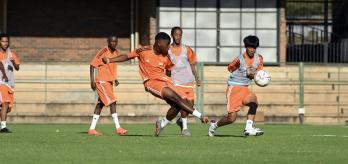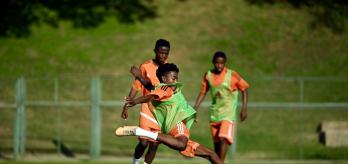Methodology
The intention: What is practised?
The objective of the exercise is to enhance a unit’s ability to create and finish within a narrow focus. There are other aspects, such as securing possession, that do not feature prominently in the exercise. The drill focuses on unit actions, including combining at pace, making movement based on a team-mate’s actions and engineering space to create goalscoring chances for team-mates. Aggressive movement and on- and off-the-ball actions, such as driving at defenders, should be performed as a unit, which can serve to commit defenders and create space for team-mates. The exercise also focuses on defensive transitions in which the attacking unit is tasked with immediately pressing on the front foot after an attack ends. The drill is scaled down to individual actions, such as the quality of finishing and the ability to deceive goalkeepers by disguising shots.
For whom is this relevant?
This attack v. defence exercise revolves around the unit, with a particular focus on attacking and finishing at pace. The drill is specifically relevant to the front three players in an attacking transition. The players who begin the sequence with the ball represent wingers or attacking midfielders who receive possession in between the defensive lines before driving forwards towards the opposition’s backline. The player occupying a position in the central zone represents a centre-forward who either drops to link play or waits for the right moment to run in behind. The wingers or attacking midfielders are asked to continue their runs to take up goalscoring positions. From a defensive perspective, the exercise simulates a backline that finds itself on the back foot and must decide whether to press aggressively or hold their ground.
How is the practice designed?
The exercise involves attack v. defence scenarios, featuring variable repetition that presents ample opportunities for a unit to practise creating goalscoring chances when attacking at pace. The variations offer the unit exposure to various options when attacking in threes in the final third. The exercise emphasises the actions of the front three and central defenders within a small, narrow exercise area that resembles the final third without the wide channels. Fast transitions and attacking waves require players to be assertive and aggressive in their actions. They are tasked with making quick decisions, with less focus placed on execution and technique. The fact that the offside rule is in place prevents attackers from simply waiting beyond the defensive line and forces them to pay attention to the timing of their runs. The rule that a goal scored by a player who begins the sequence is worth two goals encourages players to constantly think about getting into goalscoring positions after they have released the ball.
Session plan
Organisation
-
Mark out a 40x25m exercise area.
-
Position a full-size goal at each end of the exercise area.
-
Place a goalkeeper in each goal.
-
Mark out a halfway line.
-
Split the group into 2 teams.
-
Position each team beside a goal and arrange the players in pairs.
-
Place 1 player from each team in the central zone.
Explanation
-
The exercise starts with an orange player in possession.
-
The player dribbles the ball from their starting position beside the goal into the exercise area, and their partner sets off with them at the same time.
-
At the same time as the 2 orange players enter the exercise area, they are joined by 2 blue players who enter the exercise area from beside the opposite goal.
-
Once the attack is over, the 2 blue players leave the exercise area and are replaced by 2 of their team-mates, who launch an attack, with 1 of the pair dribbling the ball towards the opposite goal.
-
The pair of orange players already inside the exercise area must quickly transition into defence.
-
The sequence is repeated after every attack.
Variation 1
-
The offside rule applies, with the lines that delimit the central zone acting as the offside lines.
-
Players operating in the central zone cannot drop past their respective offside lines to defend.
Variation 2
-
A goal scored by the player who starts the sequence is worth 2 goals.
Key coaching points
Roles of coaches
-
First coach: leads the session and instructs the players throughout.
-
Second coach: supports and encourages the players from their position on one side of the exercise area.
- Third coach: supports and encourages the players from their position on the opposite side of the exercise area to the second coach.

















































